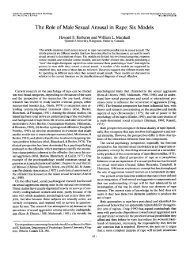Regulation of the dopamine transporter - Addiction Research ...
Regulation of the dopamine transporter - Addiction Research ...
Regulation of the dopamine transporter - Addiction Research ...
You also want an ePaper? Increase the reach of your titles
YUMPU automatically turns print PDFs into web optimized ePapers that Google loves.
DAT <strong>Regulation</strong> Schmitt & Reith<br />
obviously contribute to <strong>the</strong> formation <strong>of</strong> <strong>the</strong><br />
5-(NAC)-thioe<strong>the</strong>r metabolites. 137 Pretreatment<br />
with <strong>the</strong> antioxidant compound acetyl-L-carnitine<br />
was also shown to prevent oxidative damage to<br />
neuronal mitochondria in vivo after high-dose<br />
MDMA administration in rats. 140 These data<br />
strongly indicate that <strong>the</strong> toxicity <strong>of</strong> MDMA and its<br />
analogues is due chiefly to oxidative stress induced<br />
by <strong>the</strong> potent and selective serotonergic neurotoxins<br />
formed during metabolism <strong>of</strong> <strong>the</strong> parent<br />
compound. Moreover, <strong>the</strong>se findings suggest that<br />
avoidance <strong>of</strong> repeated dosing and concomitant use<br />
<strong>of</strong> central nervous system–penetrating antioxidant<br />
compounds are prudent harm reduction strategies<br />
for preventing or limiting <strong>the</strong> damage inherent to<br />
recreational MDMA use.<br />
If <strong>the</strong> neurotoxic effects <strong>of</strong> <strong>the</strong> MDA-type ring<br />
substituted amphetamines is due primarily to <strong>the</strong><br />
formation <strong>of</strong> prooxidant quinone metabolites, what<br />
can be said <strong>of</strong> amphetamine derivatives that are<br />
unlikely to form such unstable metabolites, such<br />
as d-methamphetamine? Despite being similar to<br />
amphetamine itself in structure, pharmacokinetics,<br />
and metabolic fate, methamphetamine exhibits increased<br />
toxicity and significantly greater abuse potential<br />
than <strong>the</strong> parent compound. 20,141 Toxic insult<br />
to both serotonergic and <strong>dopamine</strong>rgic neuronal<br />
systems after high doses <strong>of</strong> d-methamphetamine has<br />
been routinely demonstrated in experimental animals<br />
(see Cadet et al. 142 for a review). In humans,<br />
chronic high-dose methamphetamine addicts show<br />
moderate deficits in cognitive function, and in vivo<br />
neuroimaging techniques reveal decreased surface<br />
DAT concentration 143 and increased microglial activation<br />
compared with control subjects. 144 Eventual<br />
recovery from <strong>the</strong>se effects appears possible,<br />
but normalization <strong>of</strong> <strong>dopamine</strong>rgic function is an<br />
extremely slow process, taking months to years. 145<br />
Similarly to neurotoxicity associated with MDA-like<br />
substituted amphetamines, <strong>the</strong> toxic response to<br />
methamphetamine—particularly in <strong>dopamine</strong>rgic<br />
neurons—also involves oxidative stress by quinonemediated<br />
formation <strong>of</strong> ROS and subsequent activation<br />
<strong>of</strong> proapoptotic signaling cascades. 142<br />
Findings that antioxidant compounds can reduce<br />
neurotoxic insult by methamphetamine support <strong>of</strong><br />
this <strong>the</strong>ory: for example, high doses <strong>of</strong> <strong>the</strong> aforementioned<br />
antioxidant NAC ameliorate <strong>the</strong> longterm<br />
loss <strong>of</strong> striatal DAT in moneys after repeated<br />
injections <strong>of</strong> methamphetamine. 146 However, un-<br />
like with MDA/MDMA, here <strong>the</strong> likely culprit is<br />
not a metabolic product <strong>of</strong> <strong>the</strong> parent stimulant but<br />
ra<strong>the</strong>r <strong>dopamine</strong> itself.<br />
Free-floating <strong>dopamine</strong> (that is, existing outside<br />
synaptic vesicles) can be spontaneously oxidized<br />
to dopaminoquinone and successively converted to<br />
5-cysteinyl-catechol thioe<strong>the</strong>rs in a manner identical<br />
to <strong>the</strong> reaction <strong>of</strong> <strong>the</strong> MDA metabolite 3,4dihydroxyamphetamine<br />
shown in Figure 2. 147 If sufficiently<br />
large concentrations <strong>of</strong> soluble <strong>dopamine</strong><br />
are present, mechanisms to rapidly clear or safely<br />
inactivate <strong>dopamine</strong>—namely, <strong>the</strong> DAT and <strong>the</strong><br />
catabolic enzyme COMT—will presumably be<br />
saturated. Excess <strong>dopamine</strong> will thus be nonspecifically<br />
oxidized, resulting in dose-dependent formation<br />
<strong>of</strong> dopaminoquinone. How might this oxidative<br />
mechanism explain <strong>the</strong> increased toxicity <strong>of</strong><br />
methamphetamine compared with amphetamine<br />
itself? A series <strong>of</strong> experiments by Goodwin et al.<br />
systematically highlighted, for <strong>the</strong> first time, some<br />
vital differences between <strong>the</strong> two compounds in<br />
<strong>the</strong>ir respective effects on <strong>the</strong> DAT and <strong>dopamine</strong>rgic<br />
function. 20 Notably, <strong>the</strong> authors demonstrated<br />
that d-methamphetamine is fivefold more effective<br />
at stimulating <strong>the</strong> DAT to release <strong>dopamine</strong> in<br />
hDAT-expressing HEK cells than d-amphetamine at<br />
identical concentrations. Also, in vivo chronoamperometry<br />
in <strong>the</strong> rat nucleus accumbens after<br />
administration <strong>of</strong> an equivalent dose <strong>of</strong> ei<strong>the</strong>r<br />
methamphetamine or amphetamine (5 mg/kg) revealed<br />
that methamphetamine significantly prolonged<br />
<strong>dopamine</strong> clearance time compared with<br />
amphetamine, resulting in greater sustained external<br />
<strong>dopamine</strong> levels. However, no differences between<br />
<strong>the</strong> two were detected at a 1-mg/kg dose (Ref.<br />
20, Fig. 5).<br />
Thesedatasuggestthatathigh(yetequivalent)<br />
doses, methamphetamine has a far greater propensity<br />
than amphetamine to produce accumulation<br />
<strong>of</strong> excess external <strong>dopamine</strong>. The higher resultant<br />
concentrations <strong>of</strong> external <strong>dopamine</strong> conceivably<br />
contribute to <strong>the</strong> greater addictive potential<br />
<strong>of</strong> methamphetamine than with amphetamine and<br />
may also render methamphetamine more likely to<br />
cause oxidative neurodegeneration. Although <strong>the</strong><br />
specific DAT-mediated pharmacology <strong>of</strong> methamphetamine<br />
contributes to its particularly high toxicity<br />
and abuse potential, ano<strong>the</strong>r basic contributing<br />
factor is <strong>the</strong> dose and administration pattern typical<br />
<strong>of</strong> human methamphetamine addicts. Recreational<br />
332 Ann. N.Y. Acad. Sci. 1187 (2010) 316–340 c○ 2010 New York Academy <strong>of</strong> Sciences.










